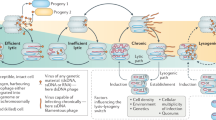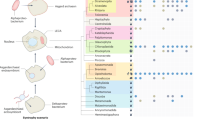Growing two long filamentous tails may help an archaeal virus to survive in a hostile environment.
Abstract
Viruses are thought to be functionally inactive once they are outside and independent of their host cell1. Here we describe an exceptional property of a newly discovered virus that infects a hyperthermophilic archaeon growing in acidic hot springs: the lemon-shaped viral particle develops a very long tail at each of its pointed ends after being released from its host cell. The process occurs only at the temperature of the host's habitat (75–90 °C) and it does not require the presence of the host cell, an exogenous energy source or any cofactors. This host-independent morphological development may be a strategy for viral survival in an environment that is unusually harsh and has limited host availability.
This is a preview of subscription content, access via your institution
Access options
Subscribe to this journal
Receive 51 print issues and online access
$199.00 per year
only $3.90 per issue
Buy this article
- Purchase on Springer Link
- Instant access to full article PDF
Prices may be subject to local taxes which are calculated during checkout

Similar content being viewed by others
References
van Regenmortel, M. H. V. in Seventh Report of the International Committee on Taxonomy of Viruses (eds Fauquet, C. M. et al.) 3–16 (Academic, San Diego, 2000).
Lupas, A., Van Dyke, M. & Stock, J. Science 252, 1162–1164 (1991).
Strelkov, S. V., Herrmann, H. & Aebi, U. BioEssays 25, 243–251 (2003).
Ausmess, N., Kuhn, J. R. & Jacobs-Wagner, C. Cell 115, 705–713 (2003).
Hermann, H. & Aebi, U. Curr. Opin. Cell Biol. 12, 79–90 (2000).
Pettit, S. C., Everitt, L. E., Choudhury, S., Dunn, B. M. & Kaplan, A. H. J. Virol. 78, 8477–8485 (2004).
Swanstrom, R. & Willis, J. W. in Retroviruses (eds Coffin, J. M., Hughes, S. H. & Varmus, H. E.) 263–334 (Cold Spring Harbor Lab. Press, New York, 1997).
Ackermann, H. W. & Bamford, D. in Seventh Report of the International Committee on Taxonomy of Viruses (eds Fauquet, C. M. et al.) 111–116 (Academic, San Diego, 2000).
Prangishvili, D., Stedman, K. & Zillig, W. Trends Microbiol. 9, 39–43 (2001).
Author information
Authors and Affiliations
Corresponding author
Ethics declarations
Competing interests
The authors declare no competing financial interests.
Supplementary information
Materials and Methods
(PDF 303 kb)
Rights and permissions
About this article
Cite this article
Häring, M., Vestergaard, G., Rachel, R. et al. Independent virus development outside a host. Nature 436, 1101–1102 (2005). https://doi.org/10.1038/4361101a
Published:
Issue Date:
DOI: https://doi.org/10.1038/4361101a
This article is cited by
-
Diversity, evolutionary contribution and ecological roles of aquatic viruses
Science China Life Sciences (2018)
-
Structure and assembly mechanism of virus-associated pyramids
Biophysical Reviews (2018)
-
“Dealing with the changeable and blurry edges of living things: a modified version of property-cluster kinds”
European Journal for Philosophy of Science (2018)
-
Abundance and observations of thermophilic microbial and viral communities in submarine and terrestrial hot fluid systems of the French Southern and Antarctic Lands
Polar Biology (2018)
-
The enigmatic archaeal virosphere
Nature Reviews Microbiology (2017)
Comments
By submitting a comment you agree to abide by our Terms and Community Guidelines. If you find something abusive or that does not comply with our terms or guidelines please flag it as inappropriate.



